Written by: Emily Seed, NEOSCIA Regional Communication Coordinator Back to Innovator Next

Cam Oglivie, Soil Health Educator, Soil Health Institute
Soil carbon sequestration—a hot topic in the industry, but what does it really mean? Cam Oglivie, (formerly the Knowledge Coordinator with Soils At Guelph), recently dived into the topic, breaking it down for those attending the 2022 OSCIA annual meeting, held on Tuesday, February 8, 2022. Ben Gordon, (Carbon & Ecosystem Services Global Portfolio Leader, Corteva Agriscience, San Francisco, California, USA), explained the Carbon Market in the USA. Rounding out the panel session was a Q&A period with Dr. Laura Van Eerd, Professor, UofG and Ben Gordon answering questions from viewers.
To understand how soil carbon sequestration works, we first need to understand soil composition. Soil is primarily made up of 45% minerals, 25% gasses, 25% water and 5% organic matter. The soil organic matter (SOM) is where we find carbon, amounting to roughly 58% carbon making up that organic matter portion. While we can’t control the mineral fraction of the soil composition, we can control pore space and soil organic matter to a certain extent.
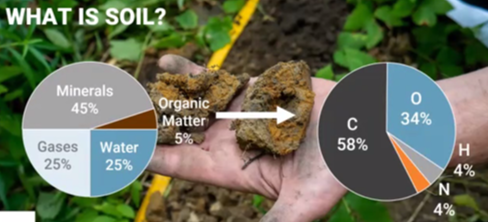
Photo Credit: University of Guelph
How does carbon get into the soil? The microbes breathe out CO2 into the atmosphere, and then plants uptake CO2 and store the carbon in the roots, which are left in the soil as organic matter. Early on in the season as the soil warms up and microbes start being active, carbon is released into the atmosphere. Throughout the growing season, as CO2 is taken up by the crop, carbon is drawn out of the atmosphere and into the system. Not all of this carbon will stay in the soil, but previous research does indicate that the carbon lost to the atmosphere and the carbon taken up into the system balances out by the end of the growing season. This also means that it is really hard to get more carbon sequestered into the soil because of the cyclical nature of the system.
Looking at the balance between carbon in and carbon out of the system in relation to crop rotations, we can see the impact of diverse vs. non-diverse rotation systems. Cam went on to show an example of a diverse system of corn with rye-clover covercrop vs. a corn only system.
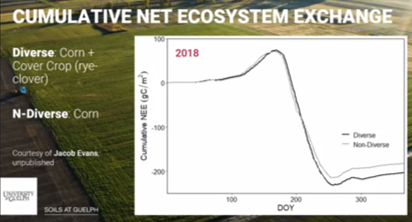
Photo Credit: University of Guelph
Looking at soybeans as an example, data shows there will be less carbon capture over the season compared to corn due to less biomass in soybeans.
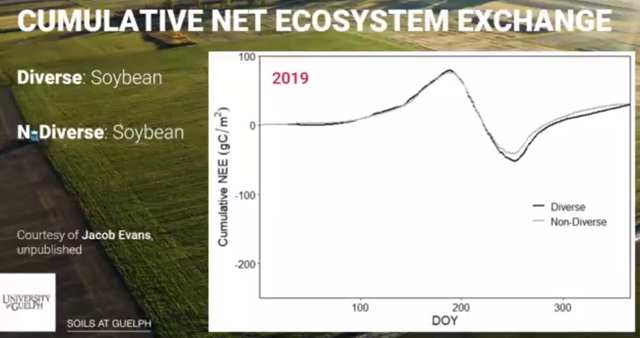
Photo Credit: University of Guelph
If we look at winter wheat with a rye-oat-clover-radish cover crop, we can see a significant impact on the carbon balance. The wheat crop is removed from the field earlier in the season (image below shows the wheat is removed around day 200). Some carbon is released back into the atmosphere during harvest, but then the cover crop is planted, and we see carbon capture happening again. The cover crop isn’t removed from the system so the soil organic matter is allowed to break down and some carbon will be incorporated back into the soil.
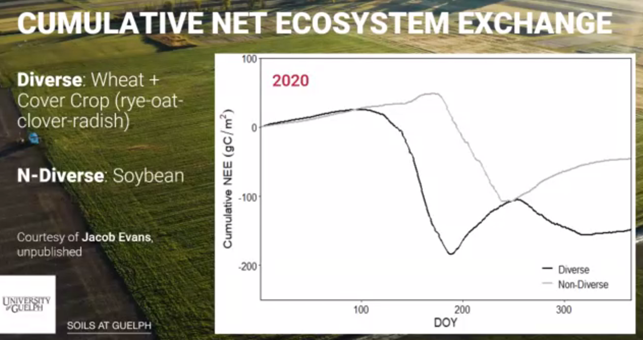
Photo Credit: University of Guelph
If we compare all three crop examples, it’s clear that keeping living roots in the ground for 365 days of the year gives us the potential to store more carbon in the soil. This work also shows us that a diverse crop rotation is less important compared to keeping living roots in the soil for most of the year.
When examining these rotation comparisons, Cam demonstrated the benefits of corn, soybeans, wheat, and red clover as they help keep living roots in the ground. Winter wheat carries roots through the winter, helping to improve soil organic matter. Also shown was the perennial crop (alfalfa) which again, has high benefits due to roots remaining in the ground year-round.
Knowing how root systems affect carbon sequestration, we can ask ourselves—as we increase soil organic matter in the soil, what do we get back? What evidence of impact can we see at the farm level? Research shows that we can expect to see higher crop yields on a normal year, but even more so during drought years (e.g. 20-30% yield increase was seen in soybeans during drought years in fields with roots in the ground as part of the rotation). In addition to improved crop yields, we also see more yield stability and resiliency.
The soil organic matter is also impacted by tillage. The microbial community is very different in a no-till vs. tillage system. A field that has been in alfalfa for 40 years, will have a very unique microbial community compared to fields tilled annually. Crop rotation counts as well! By diversifying, you open up a window with winter wheat to include a cover crop, getting living roots into the ground for 365 days of the year. Research led by Dr. Laura Van Eerd has showed that after 9 years, they are seeing 10-20 tons of carbon per hectare sequestered with cover crops compared to systems without cover crops.
It was noted that cover crops can be more profitable in vegetable cropping systems compared to field cropping systems due to the growing season length providing more of an opportunity to get better growth and establishment of the cover crop before winter, therefore allowing for more of an opportunity to reap the benefits of those living roots to feed the soil biology and improve SOM levels.
If we think about our management practices in relation to the impact of roots on soil carbon sequestration, we can understand that the rooting zone is really our management zone. This zone is affected by tillage and by root management and will be where the bulk of SOM is found. This is also the area where carbon capture in the soil occurs.
We also need to consider the tillage impact on carbon storage in the soil. Are we actually losing carbon or just diluting it as we increase the A horizon with tillage? In some environments, yes, the tillage will affect this. For other parts of Ontario, the impact is not as clear. There are other key drivers impacting carbon storage in the soil. One such example is soil type. We know that soil carbon does not increase linearly. It saturates at a certain point in time. Our management will impact the inputs of carbon and losses from the system, but eventually they will reach a new, steady equilibrium and we won’t be able to increase the carbon much beyond that point. This will depend on the soil type. For example, clay soils have a higher saturation of SOM compared to sandy soil. This creates a challenge when measuring the amount of carbon, we are storing in the soil because it will be highly dependent on soil type.
When we consider measuring for carbon credits, we need to think about the rooting zone and where carbon capture takes place. How deep should we be measuring to validate the amount of carbon stored in your soil? Do we stop at 30 cm, the bulk of carbon is stored, or do we go deeper to include the carbon captured further in the soil profile through pore space? If measuring for carbon credits, we can’t just look at the concentrated areas, but need to consider the total carbon amount over a given soil profile.
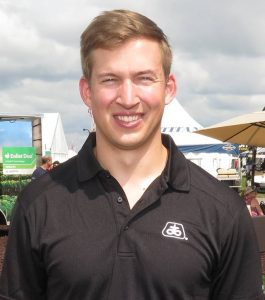
Ben Gordon, Corteva Agriscience
With this baseline understanding of carbon sequestration, Ben Gordon, joined the group to talk about carbon credit markets.
Ben explained that we are seeing voluntary carbon markets being driven by companies being forced to cut their carbon footprint. Companies are willing to pay to reduce their emissions. However, not every emission can be fully reduced, and there will always be residual emissions. They need net new change to bring them net new dollars. For these markets to function, however, there needs to be real outcomes.
Through a program in the US, a participating farmer can choose in-field practices that are deemed eligible and then log these practices. Soil samples are also taken to create a baseline. As practices are changed and we see results, we can quantify the gap that gets certified and measured, and that drives the price (based on ton per acre of carbon and price per ton). The soil tests required to measure this change are not your regular soil fertility samples. Multiple bulk density samples are needed to determine carbon capture. Models need to be used to capture carbon and nitrogen cycles to calculate the full impact.

Photo credit: Corteva.us
The challenge with these markets is that buyers want new impact for their dollars (e.g. a farmer will only be eligible on new acres with the practice, but won’t be eligible for acres by early adopters who have been doing these practices for 5-10 years). The costs to implement practices are larger than the payments currently made through these programs, so if early adopters aren’t allowed to participate, the whole market does not make sense.
Closing out the session, we learned that, despite there being many variables impacting this, our agronomic practices certainly have an impact on soil carbon sequestration.
The full video presentation of this session is available on the OSCIA membership platform as a membership benefit. Login here: https://membership.ontariosoilcrop.org/member-home/